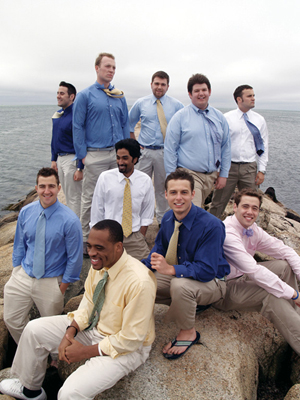Beige
About the Color
Beige combines tan and yellow elements to produce its appearance. In US culture, beige conveys neutrality, blandness, earthiness, and homely comfort.

In terms of skin color, beige is considered a "medium" tint between Ivory/Fair and Bronze/Ebony.
As a neutral color, beige goes well with vibrant colors such as crimson and lime green. These colors, which would normally appear bright and possibly annoying, are made more subtle and neutral with a beige complement.
Cultural Implications
In America, beige conveys both blandness and comfort. Perhaps beige can be summed up as familiar, which is why it produces both of these implications.

In an episode of Futurama, the boring, conformist residents of the Neutral Planet are represented with beige skin.
Beige also conveys sophistication because of its neutrality and its ability to complement many colors.

Even though the men in this photo are wearing different colored shirts, the beige khakis match with all of them.
Because beige is a pretty specific color, it was difficult for me to find its significance in other cultures. However, its parent colors, brown and yellow, have various implications internationally.
Brown
US: dullness, fertility, strength, poverty
Africa: earth
Japan: earth, strength, durability
Netherlands: architecture
Yellow
US: happiness, caution, sunshine, cowardice
Argentina: wealth, religion, ceremony
Africa: high rank, wealth
Japan: sunshine, nature
Netherlands: food
Example Websites
- Kirkland's
This furniture website uses beige to convey the warmth and comfort of home. - Hunter's
The beige on this wine website conveys sophistication and comfort, both of which these wines are meant to provide. - Dockers
This clothing website uses beige to neutralize the bright orange at the top of the page. The beige makes the site easier on the eyes and adds sophistication.
Works Consulted
Images
Beige background from jinterwas on Flickr.
Beige skin color image from Mary Kay.
Futurama image from Paper Links Press.
Men in khakis from The Hyannis Sound.
Information
The Wikipedia entry on beige includes some information on beige in US culture.
An article on color theory from Smashing Magazine explains how beige can be used in design.
The Styling Scrapbook explains how neutral colors like beige can appear sophisticated.
This PDF by The Global Propaganda provided me with information on colors in other cultures.
By Bailey Lucero-Carter. Last updated Feb. 23, 2015.